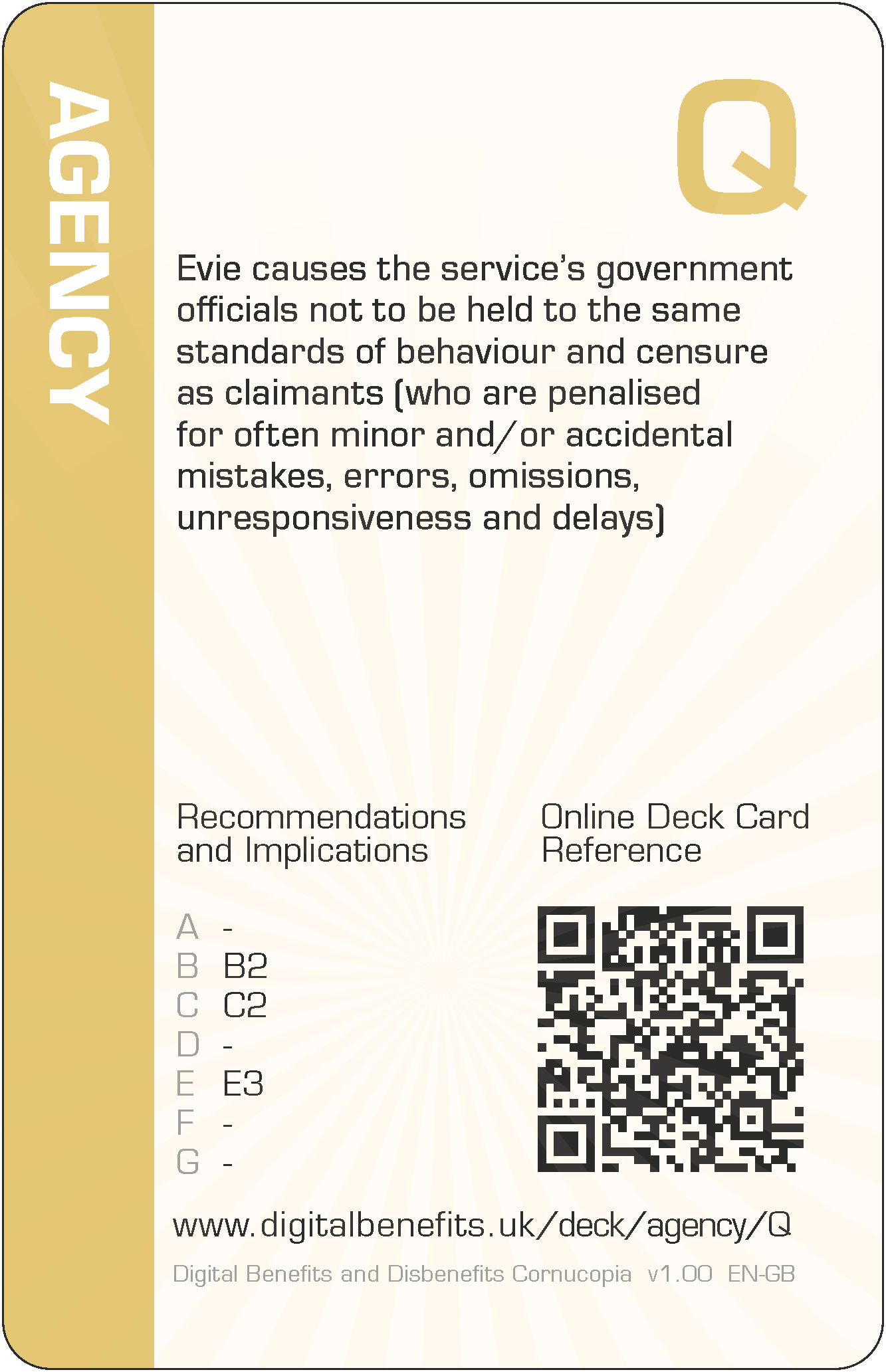Agency Q (AG-Q) Card
DBD Cornucopia > Deck > Agency > Q
Card Details - Queen of Agency
Abbreviation
AG-Q
Card's focus
The focus of this card is equality of standards and behaviour
Threat to claimants
Evie causes the service's government officials not to be held to the same standards of behaviour and censure as claimants (who are penalised for often minor and/or accidental mistakes, errors, omissions, unresponsiveness and delays)

Threat to claimants
Evie causes the service's government officials not to be held to the same standards of behaviour and censure as claimants (who are penalised for often minor and/or accidental mistakes, errors, omissions, unresponsiveness and delays).
Some examples of how this threat could lead to harms (negative effects on claimants)
The design recommendations and implications relevant to the card are listed below in the next section, but even those can be somewhat abstract and difficult to think about during practical day-to-day implementation. Therefore, some example harms are provided to complement the more formal research outputs. These examples are unique per card, and are only published on these web pages (i.e. in no other project outputs).
- Claimants are sanctioned for missing telephone meetings, whereas there seems to be no comeback when government officials rearrange meetings, often with very little notice, and claimants have already paid extra for childcare during the original slot
- Errors which affect the service's quality such as reliability, accuracy and integrity, made by government officials in workplace situations (e.g. as employees, as contractors, as agency staff), are treated with less severity than claimants who have similar failings, but the relative impact of official failures on each claimant is much greater than vice versa
- Claimants are given much less time to do part of an activity than government officials have to do their part, leaving a feeling that the system is unfair
The examples are to help understand the threat on the card, not to suppress thinking and innovation. Incorporating these examples exactly, or closely matching ones, should be scored down when playing DBD Cornucopia as a game.
Applicable design recommendations and implications
These are reproduced here from Research Briefing N
Acknowledge claimants as people in digital design
- Ensure system and state accountability to claimants
Equalise accountability between claimants and the state. Promote a sense of fairness by enforcing an expectation that service level standards for actions and response times should be similar to those expected of claimants, with related penalties not disproportionately, or only, affecting claimants. Provide tools/methods for claimants to easily check, query and challenge actions and decisions.
Reduce claimants’ interaction burdens with digital welfare
- Provide greater flexibility and accommodations for claimants in the accuracy, precision, timeliness and permanence of the remaining information they provide
Design for people's lives which can be complex and where changing events and circumstances, often beyond their control, drive their need and eligibility for social protection payments. Allow adequate, rather than complete and precise, data that suffice for the state's needs. Increase flexibility of use by avoiding strict deadlines; limiting the use of actions that block progression; permitting correcting, updating and reversing information; and withdraw penalties for simple slips and lapses.
Design systems which support the division of labour with claimants' ecosystems
- Recognise changing trust effects in design of digital systems
Claimants have different opinions about the trustworthiness and motivations of the state, unfamiliar claimants and other actors, which affect their tolerance to accept harms, requiring flexibility in choosing assistance and recognition how this trust can change over time: prior to making a claim, while maintaining a claim, and after ceasing to be a claimant.
General Notes
Card values (i.e. 'Queen' for this card) are for game play and are not correlated with the severity of harm. This is because threats cannot be ranked directly since they can affect individuals in different ways due to situations and circumstances, or affect fewer or more claimants, or the harms can arise in claimants' support networks and wider society.
The threat description uses a person's name as the "attacker" (i.e. 'Evie' for this card), which can be thought of someone involved with implementation. They could have any role which influence digitisation. So they could be a database administrator, or a copy writer, or a quality assurance specialist, etc, or all of these. Everyone could have some influence on the claimant threat described. The names were randomly selected from those currently most popular as given names for boys and girls (UK Office for National Statistics).
The example harms provided are drawn from the research data (which explored not only parts of existing services but also the effects of possible changes to those), from the author's own knowledge of web application development and testing, the author's own experience of helping citizens to claim Universal Credit (UC) and Personal Independence Payment (PIP), and from suggestions submitted by other people (make a suggestion). The threats and example harms do not necessarily exist in the current UC or PIP deployments or in ecosystems around those services, but they might well do.
All the cards in this Agency suit are: 2 3 4 5 6 7 8 9 10 J Q K A
The other suits in the deck are: Scope, Architecture, Trust, Porosity and Cornucopia (plus Jokers).
